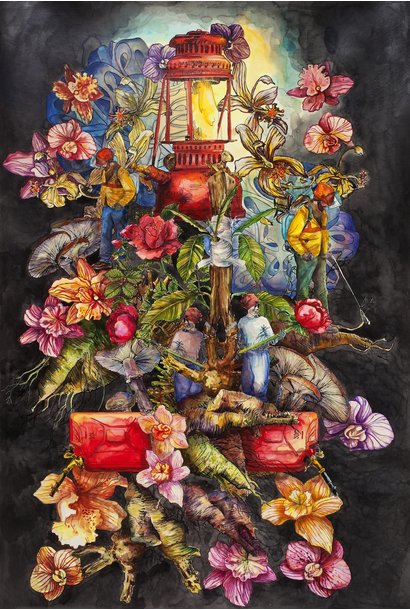

Cynthia Dinan-Mitchell “Mood Lighting”, Cynthia Dinan-Mitchell
C$ 0.00 Excl. tax
- File number: EXHI1057
...
Cynthia Dinan-Mitchell’s exhibition, entitled Mood Lighting, contains hand painted screen prints that illustrate a contemporary twist on vanitas. The style and composition of the work is typical of the vanitas genre: images of skulls, flowers, and other objects are carefully arranged, vividly lit, and highly saturated with a burnt umber palette. Candles are replaced by lightbulbs, spotlights, desk lamps, and flashlights, which reflects our society’s shift toward artificial lighting; radios and satellite dishes extend references further into the technological advancements of the twentieth century. There is a pulse emanating in the work that weaves through modern history, presenting current environmental issues through an historical lens.
Mood Lighting consists of artificially lit night scenes with nocturnal, crepuscular, and diurnal creatures. The display window of the exhibition presents two opposing pieces that depict a wolf (predominantly nocturnal) and a rabbit (predominantly crepuscular—meaning most active in the twilight hours of both sunrise and sunset). Diurnal creatures, such as monkeys and vultures, are portrayed in other works throughout the exhibition. Mirroring alarm clocks allude to time going both forward and backward simultaneously. Symmetry and asymmetry exist side by side. Human skulls are portrayed alongside the skulls of rams. Other symbols of nature and technology seem to intersect more loosely: wasps, botanical illustrations, boomboxes, conservatories, scissor lifts, eels, and coffee percolators.
Vanitas is a genre of morbid and explicit art associated with still life paintings in the Late Medieval and Northern Renaissance periods. The paintings often depict objects of death and decay, reminding viewers of the impermanence of life, the futility of earthly achievements, and the emptiness of pleasure. The word vanity stems from the Latin word vanitas. The dichotomy of good and evil, heaven and hell, right and wrong, and body and soul, was central to Christian belief systems of the time.
Black and white dualism, in many forms, was present in western thought for centuries. Although modernism tended to deny the body-soul dualism, Cartesian thought brought to the forefront another dualism, that of the subject-object, the distinct separation between the internal conscious self and the external physical world, which provided a framework for understanding the human condition into the eighteenth and nineteenth centuries. In the twentieth century, post-structuralism and postmodernism challenged binary oppositions, resulting in a more pluralistic view of humanity and its environment.
Appearing in multiple instances throughout Mood Lighting are mushrooms, which are saprobic and rhizomatic organisms that spread without a central root, spot of origination, or logical pattern. The rhizome has been a recurring symbol in post-structuralist and postmodern thought, most famously represented in the 1972 work Capitalism and Schizophrenia by philosophers Gilles Deleuze and Félix Guattari. In Mood Lighting, why are we observing a postmodern reinterpretation of a vanitas? When is revisiting this moral compass useful? What imagery would we use as a contemporary metaphor for life and death? What might represent our relationship to lightness and darkness? How might current ethical issues be staged as a dramatic warning sign for our society?
In his 2013 non-fiction book, entitled The End of Night: Searching for Natural Darkness in an Age of Artificial Light, Paul Bogard presents his research into the gradual disappearance of true darkness from the night skies. One million years of evolution has made us afraid of the night, and our efforts to dominate the natural absence of light are having enormous and fascinating consequences on ourselves and our environment. It is estimated that due to light pollution, one billion birds die per year, as their migration is disorientated by artificially lit cities. Newly hatched sea turtles rely on the night sky to orient themselves toward the ocean—light pollution has been attributed to a disruption in this evolutionary instinct, which has resulted in a reduction in their population.
83% of humans are exposed to light pollution. Sleeping without adequate darkness prevents the production of melatonin in humans, which is an antioxidant needed to combat cancer. Our view of the cosmos has been masked by a haze of mood lighting, to the extent that some of the worlds most sophisticated terrestrial telescopes have been made redundant; when standing on earth, the degree of darkness that is needed to observe distant sources of light is disappearing.
The binary, moralistic, and hierarchical notions of right, wrong, light, and darkness—represented in the vanitas—have generally been challenged by postmodernists. In a metaphorical sense, light pollution itself is a physical manifestation of this shifting philosophy, whereby the night or true darkness, is being masked by a constant glow of artificial light that provides a barrier between us and the universe. Our position within the depth of the universe is out of reach for the naked eye, and as a result, have we lost our moral compass? Is this part of what makes it difficult for us to view the environment with a shared sense of responsibility?
Curated by Justin Muir
Cynthia Dinan-Mitchell received a bachelor of fine arts from Concordia University (Montreal) in 2002 and a masters in visual arts from Laval University (Quebec City) in 2007. She lives and works in Quebec City and is represented by D’Este gallery in Montreal. Solo exhibitions include Open Studio (Toronto), CIRCA art actuel (Montreal), TRUCK (Calgary), and the Musee national des beaux-arts du Quebec. This is her first exhibition in British Columbia.



